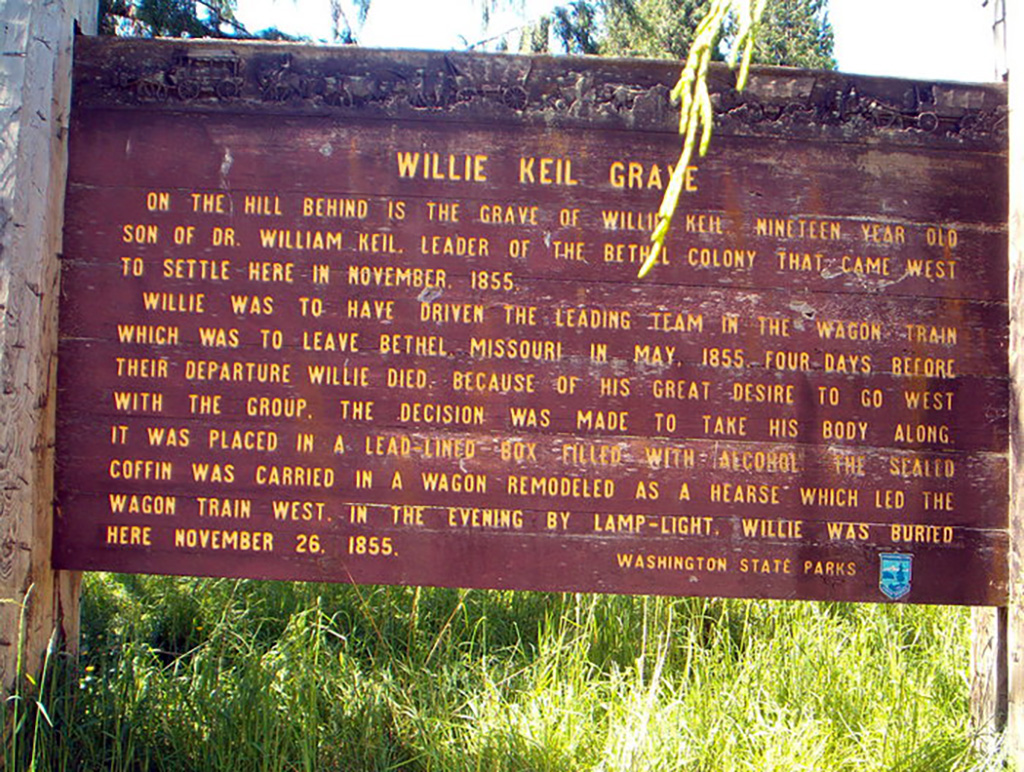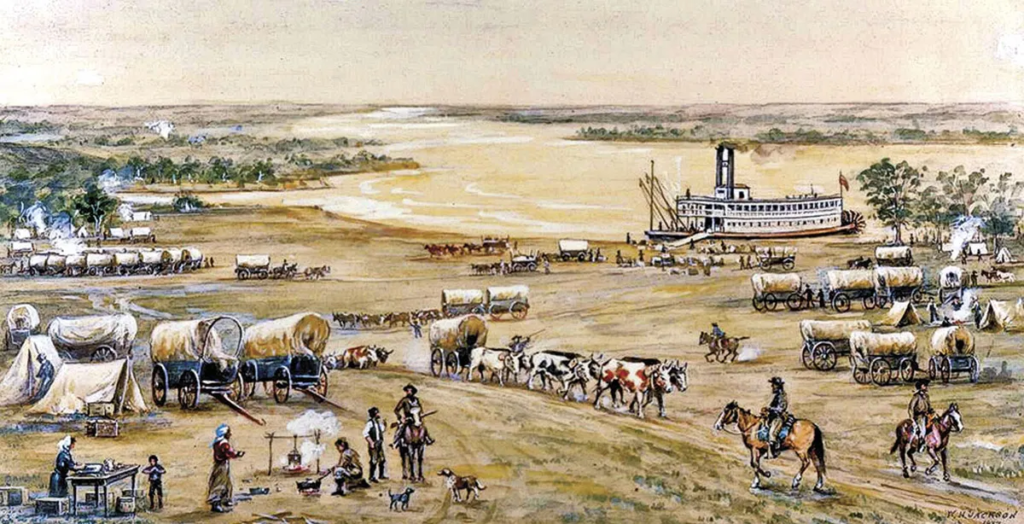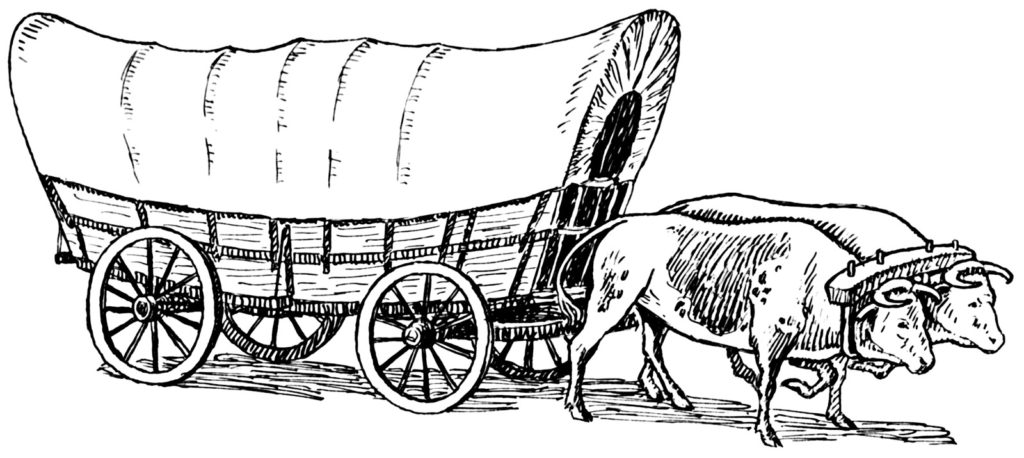1840 and the American frontier is on the move, the United States holds a restless population of 17 million. Many intrepid souls have already begun the journey to a new life; it will test and retest the stubborn and will defeat the weak. The Corps of Discovery and the word of mouth tales told by men who penetrated the wilds will become the trail bosses and leaders that will take these souls to a new life.
Two events in 1843 would illuminate the Oregon Trail. Dr. Marcus Whitman returning from a trip back east would lead a wagon train from Ft. Hall in present day Idaho to the confluence of the Columbia with the Snake and Walla Walla Rivers in present day south east Washington. Capt. Charles Fremont would survey and map the Oregon Trail from South Pass through Ft. Hall to the Columbia River as far as The Dalles, Oregon.

The trails beckon, news from the west began to filter back with alluring details of rich lands for settlement. The move by Americans into Texas, New Mexico Territory, California and the Oregon Country was not to be denied. A Continental America was about to become reality.
The decision to leave the more settled parts of America for the wilds of the west is as fraught with danger as an ocean voyage. It was not without firm consideration that the decision to trek across the continent was arrived at. With the decision made, the task of preparing for the journey began. Many would start the trek with little knowledge of neither the conditions they would meet nor the things they would need in order to conquer a continent.
For some, in order to avoid winter travel in the mountains, the trek begins one year earlier as they cross the Appalachian Mountains, winter on the Mississippi River and arrive the following spring at one of the jump off points. These intrepid souls have up to 7 months more travel when they leave Independence. But it was not only people from east of the mountains but the restless and highly energetic people east of the Mississippi that also contributed to the flow.

A clarion call, one that called out, “Oregon or Bust”, an irresistible call to some.
Bethel, Missouri, 1853 and young Willie Keil has gotten the “Oregon Bug”. For two years Willie watched as trains left for Oregon, his enthusiasm finally won over his family, extracting a promise from his father, Dr. Wilhelm Keil by agreeing to lead the train across the Oregon Trail.
Shortly before the train was scheduled to leave, 19 year old Willie became very ill and suddenly died. His father vowed to take his son to Oregon, thus began the saga of”A Dead Man leading a wagon train to Oregon”.
Dr. Keil ordered a lead lined coffin, filled it with good whiskey (Golden Rule Brand) and put Willie’s body into the coffin. He also had a special hearse constructed; it was Willie and his hearse that would be the lead wagon for the train.
Indian reprisals were extracting a heavy burden on trains crossing the plains, but rumors of Willie Kiel’s journey circulated through the Indians. On several occasions these fierce warriors gazed upon Willie’s remains, were amazed and moved by the compassion of Dr. Keil in his effort to take his son to Oregon. Needless to say, this train moved through Indian country virtually undisturbed.


Willie Keil lies undisturbed today along the Willapa River in rural Pacific County Washington. Willie’s dream of coming to the Oregon Country was carried out by his father; the promise to young Willie Keil was fulfilled.
It was here, Independence, Missouri the furthest stop for steamboat traffic on the Missouri River that the settlement of the west began. It would become the place where most of the migrants would finally be able to complete the myriad of items they would need to survive and arrive at their destination. It was here, the jump-off place to the west, where wagon masters laid down the rules by which the train would operate on its way. It was here, the last place to complete the outfitting of a train; everything from a new Conestoga wagon to horse shoe nails, staples, medicines, tools, all was available including livestock and packing equipment. It was here they would sort through the belongings they had and decide what to sell if possible or abandon. As gut wrenching as that pare down was, it was as they would find necessary.

Horses, mules or oxen could be a quandary to some but it could almost be foretold in mileage. Horses were faster than oxen and on par with mules. Other than saddle stock though, few horses were used on the trails as they were good for approximately 1,000 miles before replacement became necessary and had to be fed some grain daily. Mules were stronger for longer periods of hard travel and were considered good for 1,500 miles but they too required grain to keep up their vitality. The last and most common draft animal was the ox, an animal that could work as well as survive on the rough graze without the need for grain. A young ox was considered good for 2,000 miles, just about the distance from Independence, Missouri to Oregon City, the western terminus of the Oregon Trail.

The most common wagon on the majority of the trails west was the Prairie Schooner, a basic renovation of the Conestoga wagon. Its robust design with big wheels and wide tires allowed it to traverse rugged terrain more easily. The wagon box measured 3’ 6” wide at the floor by 10’ long with slanted side boards making the wagon box 4’ to 5’ wide at the top of the sideboard. Hickory bows and the canvas top soaked in Linseed Oil to repel moisture completed its Prairie Schooner look. Pulled by two to four oxen, it could reliably carry 3,000 pounds but wagon masters recommended a lesser weight limit to save the draft animal’s strength for the hard months ahead.
Herein lay the dilemma, how to balance the needs of the family and the needs of the draft animals. Often human needs took a back seat as the draft animals could mean the difference between life and death. Often tools with wood handles had the wood removed to reduce weight, a plow minus its wood components could save 20–30 pounds; clothing sewn in bags rather than packed in trunks could save an additional 20-30 pounds. Many heirlooms would find new homes as the pioneers bargained and bought the supplies to sustain their needs as they traveled west.
Most trains consisted of 20-25 wagons, especially in the early years of the Oregon Trail. Wagon masters demanded the migrants purchase extra wagon tongues, axles and other parts that tended to break. This cost was shared by all the members of the train as was the practice of the day. He recommended that they have extra draft animals but it was not mandatory.

Wagon masters, most of them were near despots demanding total control. This often caused some dissention but the wagon master prevailed as it was he that knew what lay ahead. Most wagon masters had a standard supply list that he often inventoried personally to make sure the migrant had enough to sustain his party. This was done to make sure that no one had to depend on other members of the train for sustenance.
The mandatory provision list would be his first concern. The following list was for each adult age 14 and up with half rations for those under 14 depending on the size of the child.
Food: Flour- 200 lbs; Bacon-150 lbs; Coffee -20lbs; Sugar -25lbs; Salt -20 lbs; Rice -20lbs; Beans -50 lbs; Pilot Bread -30 lbs; Saleratus (Baking Soda)-2 lbs; ½ Bushel Corn Meal; ½ Bushel Parched Corn; ½ Bushel Wheat Shorts (coarse ground whole wheat).
In addition the migrant was advised to carry the following medicines: Quinine; Laudanum; Opium; Citric Acid Crystals; Lemon Balm and Chamomile; Whiskey and Hartshorn. They were also advised to take; Latex Sheeting; Grease pot for the wagon, an Awl, twine, leather stings and a sewing kit with needles, thimble and thread.
All is ready; pack trains and wagon trains are ready to head out to the far flung trading posts and Army forts. Army trains vie with civilians for space as they wait for ground to firm enough to drive the wagons across the prairie.
The greatest westward migration in the history of the United States is about to unfold.
Ed Note: the fourth and final installment of this fantastic series will be published next Monday.